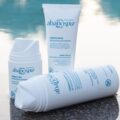Among the therapeutic activities associated with thermal waters (balneotherapy, inhalations, irrigations, etc.), mud therapy plays a fundamental role. “Mature mud” is the final product of a process influenced by multiple factors, each essential to achieving the therapeutic properties of the compound and its use in medical practice.
The essential elements are:
- The liquid component, consisting of mineral water with specific temperature and chemical composition characteristics.
- The mineral or telluric component, defined by the specific chemical composition and granulometry of the clay used. The mineral or telluric component of thermal mud is naturally occurring, specifically natural blue clay.
- The blue clay used in mud therapy is a hydrated aluminum silicate, salified with mono- or divalent cations (Me).
- The biological characteristics of the ecosystem in which the maturation process takes place.
- The maturation process itself.

The chemical composition of the clay includes the following elements in percentage proportions:
- 10% Magnesium (Mg)
- 15% Aluminum (Al)
- 45% Silicon (Si)
- 0.2% Sulfur (S)
- 0.3% Potassium (K)
- 22% Calcium (Ca)
- 0.3% Iron (Fe)
Texture Composition:
- 6% Sand
- 4% Clay
- 0% Silt
Granulometric Analysis:
- 40% Particles with a diameter smaller than approximately 20 microns
- 40% Particles with a diameter between approximately 20 and 50 microns
- 10% Particles with a diameter between approximately 50 and 100 microns
- 10% Particles with a diameter larger than 100 microns
The natural clay is extracted within the B.I.O.C.E. area in Arquà Petrarca, near Lago Costa d’Arquà.
The extraction is regulated by Regional Law 40/89 and the Thermal Resource Utilization Plan (P.U.R.T.).

The maturation process of the clay in contact with thermal water is fundamental. This process involves keeping the clay compound in contact with thermal water in dedicated tanks for a period of no less than 60 days. During this time, the clay undergoes progressive colonization by bacteria, protozoa, and, most importantly, microalgae (such as Diatoms and Cyanophyceae) that are naturally present in the Euganean Thermal Basin ecosystem.
The maturation process consists of two phases: an initial treatment phase of the clay and a second phase in which the material develops the characteristics that make it mature and therapeutically active.
The transformations occurring during maturation are highly specific to each type of thermal mud and cannot be replicated outside a defined reactive framework based on three macro-parameters:
- Water
- Raw clay
- Ecosystem
These factors influence all biological and chemical parameters of the system, including the development of algae and microorganisms and the presence of trace chemical elements.
The final composition of a therapeutic mud should be assessed in light of current scientific knowledge, particularly within the renewed pharmacological concept that views the skin as a system capable of slow and controlled absorption of therapeutic compounds. This perspective recognizes thermal mud as a highly complex molecular system with significant therapeutic potential.
Mature mud is a dynamic equilibrium system, composed of raw clay components, water elements, and an array of molecular species resulting from the metabolism and catabolism of biological organisms. The maturation tanks at AbanoRitz provide a natural habitat for these species, allowing for the development of a unique and therapeutically active compound.
Mature mud organizes itself into micellar systems, which can be compared to liposomes. These structures play a key role in skin absorption, directly influencing the therapeutic activity of the mud.











